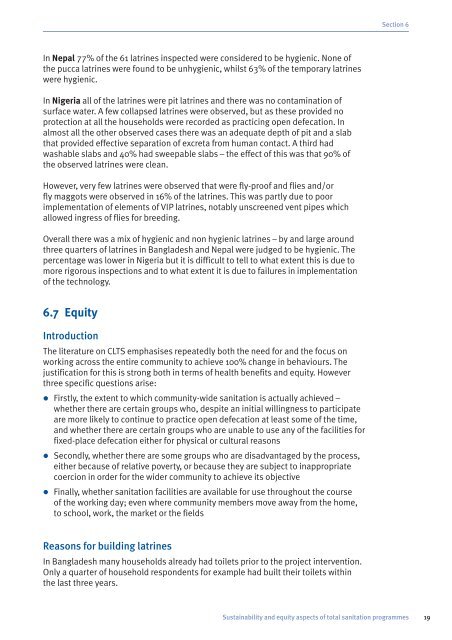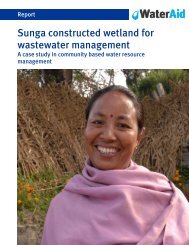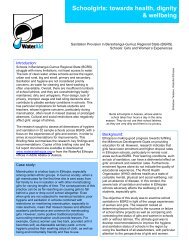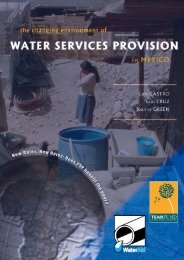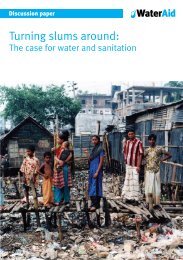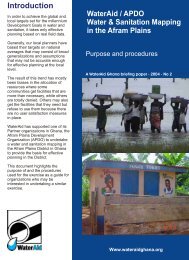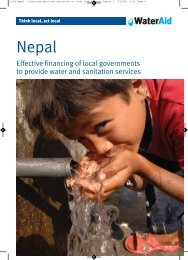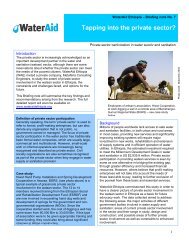Sustainability and equity aspects of total sanitation ... - WaterAid
Sustainability and equity aspects of total sanitation ... - WaterAid
Sustainability and equity aspects of total sanitation ... - WaterAid
Create successful ePaper yourself
Turn your PDF publications into a flip-book with our unique Google optimized e-Paper software.
Section 6In Nepal 77% <strong>of</strong> the 61 latrines inspected were considered to be hygienic. None <strong>of</strong>the pucca latrines were found to be unhygienic, whilst 63% <strong>of</strong> the temporary latrineswere hygienic.In Nigeria all <strong>of</strong> the latrines were pit latrines <strong>and</strong> there was no contamination <strong>of</strong>surface water. A few collapsed latrines were observed, but as these provided noprotection at all the households were recorded as practicing open defecation. Inalmost all the other observed cases there was an adequate depth <strong>of</strong> pit <strong>and</strong> a slabthat provided effective separation <strong>of</strong> excreta from human contact. A third hadwashable slabs <strong>and</strong> 40% had sweepable slabs – the effect <strong>of</strong> this was that 90% <strong>of</strong>the observed latrines were clean.However, very few latrines were observed that were fly-pro<strong>of</strong> <strong>and</strong> flies <strong>and</strong>/orfly maggots were observed in 16% <strong>of</strong> the latrines. This was partly due to poorimplementation <strong>of</strong> elements <strong>of</strong> VIP latrines, notably unscreened vent pipes whichallowed ingress <strong>of</strong> flies for breeding.Overall there was a mix <strong>of</strong> hygienic <strong>and</strong> non hygienic latrines – by <strong>and</strong> large aroundthree quarters <strong>of</strong> latrines in Bangladesh <strong>and</strong> Nepal were judged to be hygienic. Thepercentage was lower in Nigeria but it is difficult to tell to what extent this is due tomore rigorous inspections <strong>and</strong> to what extent it is due to failures in implementation<strong>of</strong> the technology.6.7 EquityIntroductionThe literature on CLTS emphasises repeatedly both the need for <strong>and</strong> the focus onworking across the entire community to achieve 100% change in behaviours. Thejustification for this is strong both in terms <strong>of</strong> health benefits <strong>and</strong> <strong>equity</strong>. Howeverthree specific questions arise: Firstly, the extent to which community-wide <strong>sanitation</strong> is actually achieved –whether there are certain groups who, despite an initial willingness to participateare more likely to continue to practice open defecation at least some <strong>of</strong> the time,<strong>and</strong> whether there are certain groups who are unable to use any <strong>of</strong> the facilities forfixed-place defecation either for physical or cultural reasons Secondly, whether there are some groups who are disadvantaged by the process,either because <strong>of</strong> relative poverty, or because they are subject to inappropriatecoercion in order for the wider community to achieve its objective Finally, whether <strong>sanitation</strong> facilities are available for use throughout the course<strong>of</strong> the working day; even where community members move away from the home,to school, work, the market or the fieldsReasons for building latrinesIn Bangladesh many households already had toilets prior to the project intervention.Only a quarter <strong>of</strong> household respondents for example had built their toilets withinthe last three years.<strong>Sustainability</strong> <strong>and</strong> <strong>equity</strong> <strong>aspects</strong> <strong>of</strong> <strong>total</strong> <strong>sanitation</strong> programmes19


